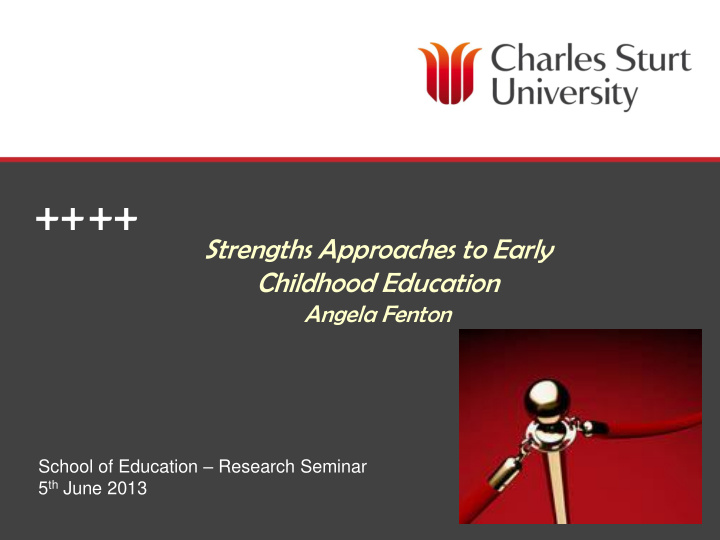



Strengths Approaches to Early Childhood Education Angela Fenton School of Education – Research Seminar 5 th June 2013
Doctoral Research: A Strengths Approach to Child-Protection Education Direct link via digital thesis ResearchOnline@JCU: http://eprints.jcu.edu.au/24044/1/01thesis.pdf
Research Opportunity Doctoral Research: To explore the ‘Strengths Approach’ (McCashen, 2005) to child protection with a group of early childhood pre-service teachers Present and examine responses for the: Possibility of enhancing teacher preparation to protect children Potential of approach in education (outside of its social service/psychology origins)
Strengths Approach • Dependent upon positive attitudes about people‟s [ children's ] dignity, capacities, Dr Donald O. Clifton Founder Strengths rights, uniqueness and commonalities Psychology • Emphasises people‟s [ children & teachers ] ability to be their own agents of change • Enables people [ children & teachers ] to identify, value and mobilise their strengths as opposed to compensating for their deficits The Strengths (Adapted from McCashen, 2005, p. v) Approach links to power & knowledge Social Services concepts in major education theories. Moving beyond “child rescue” to raising resilience
What boundaries does the research cross? • Literature Review Inter-disciplinary Psychology, Social boundaries Services, Health & Education literature informs the research • Methodology Education sector Participants transition boundaries from Pre-service to practising teachers Researcher from teacher educator to colleague • Findings - Rethinking Conceptual boundaries how we view and approach child protection preparation
Literature Review Findings Teacher Preparation Child Abuse Mass of reports Some research studies • Abuse global/Australia • Teachers overwhelmed • Qld/local stats • Fear & anxiety • Definitions/history • Changes to legislation • Effects of abuse • Calls for a new model • Health literature • Education literature Child Protection Strengths Approach Few studies Contemporary Research • Informal/ descriptive • Therapeutic applications • Adjunct programs • Positive Psychology • Resiliency links • Integrated, critical, • Potential for mentoring, & resources education/critiques • Social service literature
Methodology Organisation: Early Childhood pre-service teachers complete an integrated strengths-based child protection module Dual role teacher/researcher - ethical considerations and boundary considerations – role as teacher educator/colleague Data collected: 3 Phases - during module (students), post teaching prac, 12mths after module as graduating (practising teachers) Qualitative study - Strengths principles inform the theoretical framework Collaborative, power with rather than power over - social justice Uses existing strengths and resources
Collecting responses & Analysis Participant narratives from: Electronic Discussion Board & Email responses (EView) Interviews (Open View) and Focus Groups (Open Focus) Analysis: Thematic (zoom out) group responses to research themes: child abuse & protection, teacher prep & strengths approach Contextual (zoom in) individuals & context of first responses to module, teaching practice experiences & preparation for graduation Interpretations link to lit review findings and strengths approach principles and a layer of contextual analysis is added
Early Responses: Telling the story “While I was on one prac the teacher told me that a child in the class had recently stated to her mother that she had been sexually abused by a family member. As I reflect upon the situation, I realise that I tried to deny that this child had been abused. It was not a case of not believing the child, but I just did not know how to react to this child anymore. Also, I did not want to think of the horrible experience and the negative impact it would, and had already, had on that child's life.” (Participant 7)
Phase 2 „I think that the strengths based approach offers a way of thinking about how we react to certain situations and how these situations make us feel…The thing that I like the most about what I have learnt so far is the idea of changing the frame. Through changing the frame, it gives us a whole different way of thinking about who we are and what is possible for us‟ (Participant 19). Limitations: Scale, contextualised, further work needed
Overall Tentatively positive - A Strengths Approach appeared to enhance preparation to protect children for the teachers in the study – though adaptations needed Individualised vignettes show increased confidence to discuss and explore strategies to address child abuse with children especially in Phases 2 & 3 - though scaffolded Findings confirmed literature suggestions of heightened anxiety, expressed elevated emotions, knowledge of responsibilities & explored idea of educational neglect Showed engagement with Strengths Approach as potentially useful for education contexts as well as therapeutic contexts 11
Doctoral related Publications Peer reviewed publications: University of Sydney „Communities and Change‟ 08 - Caution children crossing ahead: Child protection education with pre- service teachers using a strengths approach http://ses.library.usyd.edu.au/bitstream/2123/ 3910/1/Chapter%209.pdf International Journal of Pedagogies and Learning (USQ) 2008 - From strength to strength: An educational research journey http://pubs.e- contentmanagement.com/doi/abs/10.5172/ijpl .4.5.90 Practitioner publications: „Building Blocks‟ Child protection resource kit 04. 12
New research/publications – Strands of research • Methodological Opportunities: A Strengths Approach – AARE 2010 Conference http://ocs.sfu.ca/aare/index.php/AARE/AARE_2010/paper/view/1832 • Using a strengths approach in early childhood education across the „preservice - inservice‟ boundary – AARE 2011 Conference Symposium • Work Integrated Learning – Using a Strengths Approach to Collaborative Education – Australian Collaborative Education Network Conference 2012. Asia Pacific Journal of Cooperative Education http://acen.edu.au/2012conference/wp-content/uploads/2012/11/108_Using-a- Strengths-Approach-in-Collaborative-Education.pdf • Accepted: Supporting Early Childhood Pre-Service Teachers in Their Work with Children, and Families with Complex Needs: A Strengths Approach – coauthored with Dr Laura Piazza – Journal of Early Childhood Teacher Education • Under Review: Supporting Early Childhood Services: Strengths Approach Case Studies coauthored with Kerryann Walsh, Tamara Cummings, Sandie Wong • In preparation: Spiritual Development and Protection in Early Childhood: A Strengths Approach – Dr Jane Bone • Conceptual: Strengths based Eview development: Eresearch – with Dr Penny Cooke 13
Questions? Thankyou, Contact:afenton@csu.edu.au Tel: (02) 60519148 SOE (Albury) Rm124 14
Recommend
More recommend